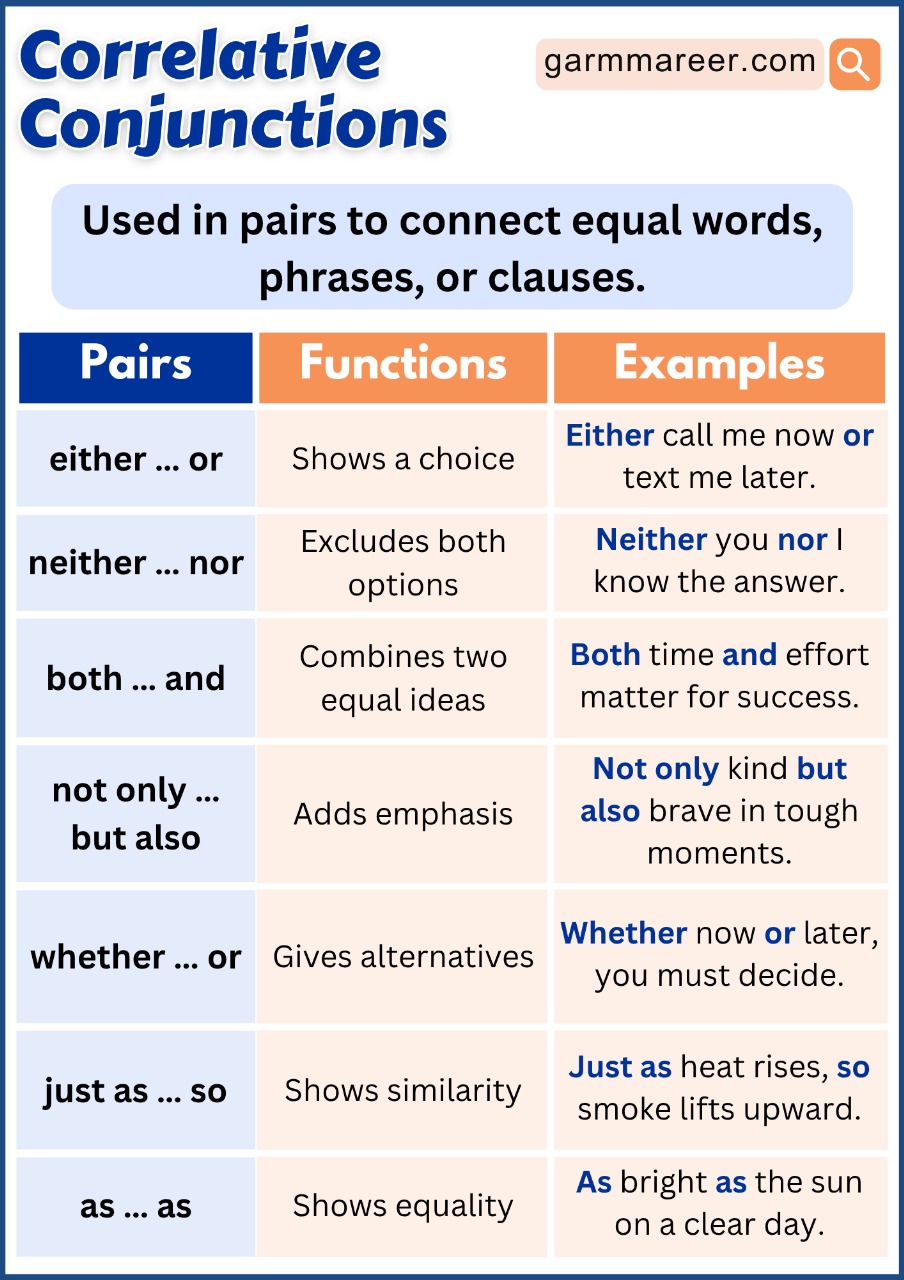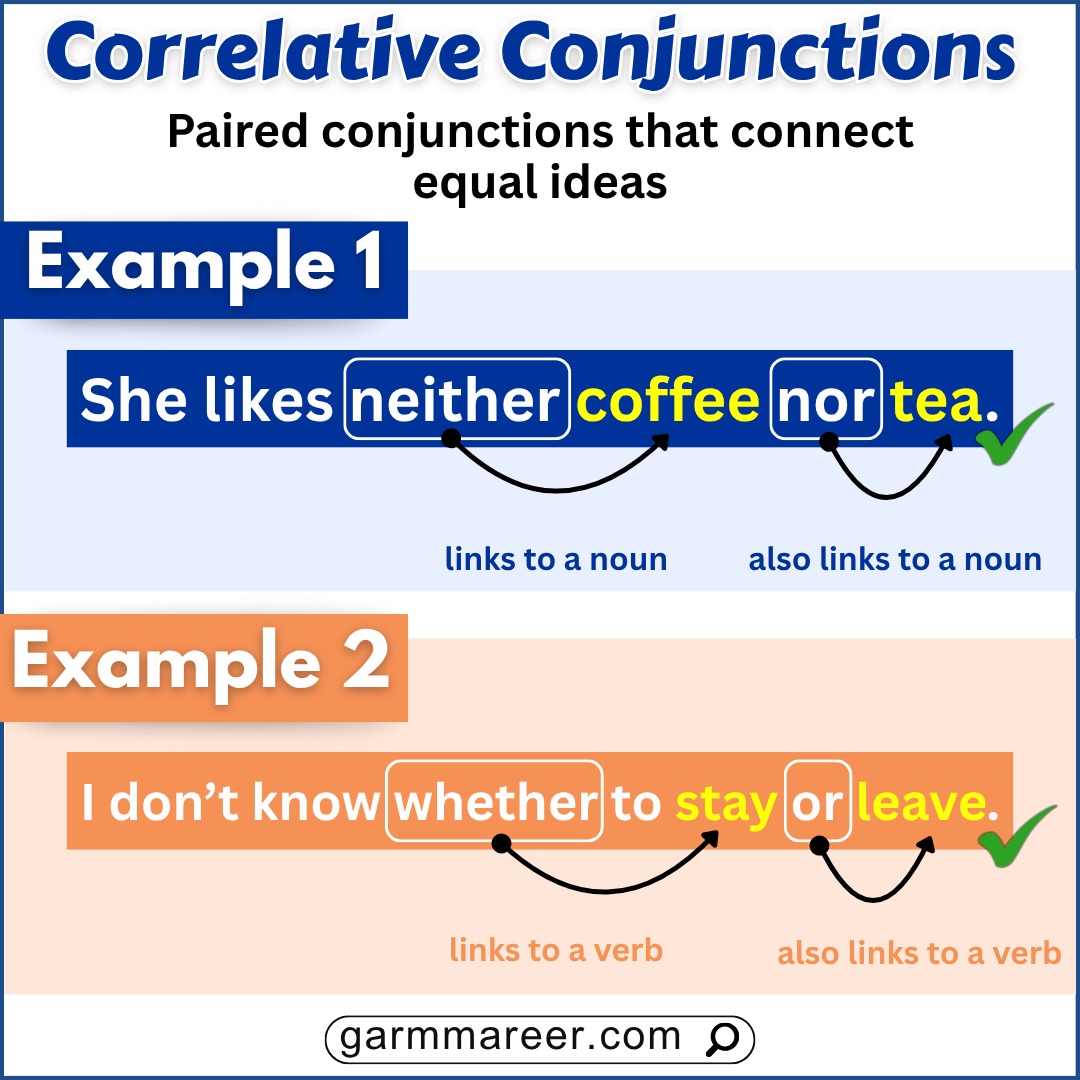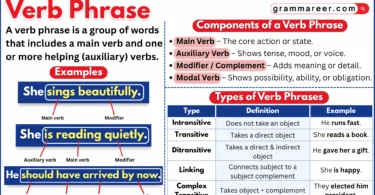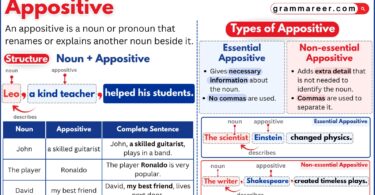Correlative conjunctions are pairs of words that work together to link ideas. You use them more often than you realize. Anytime you say something like either this or that or not only this but also that, you’re using a correlative pair. These word pairs help your sentences flow better and make your meaning clearer. Once you learn how they work, you’ll start spotting them everywhere.
In this article we’ll learn about correlative conjunctions and how they help us connect ideas in a clear, natural way.
Table of Contents
What is a Correlative Conjunction?
Correlative conjunctions are pairs of words that work together to connect ideas in a sentence. They always come in twos, like either…or or not only…but also, and help show how two parts of a sentence relate to each other.
For example:
- You can either take the bus or walk to school.
- Not only did he finish his homework, but he also cleaned his room.
These word pairs make sentences smoother, clearer, and more balanced. They can show choices, results, or simply link two equal ideas in a sentence. Using them correctly makes your writing sound natural and easy to follow.

Understanding the Role of Correlative Conjunctions
Correlative conjunctions help connect two equal parts of a sentence. These parts might be two nouns, two verbs, two adjectives, or even two phrases that serve the same purpose. The idea is that both sides carry the same weight in the sentence.
Examples:
- She packed both her laptop and her notebook for the meeting.
- They not only cleaned the house but also cooked dinner.
- I can’t decide whether the movie was confusing or creative.
Correlative conjunctions are just one type of conjunction. There are two other types you should know about: coordinating conjunctions and subordinating conjunctions.
Coordinating conjunctions connect two elements that are equally important in a sentence—like two nouns, two phrases, or even two complete sentences. These are the classic connectors most people learn first. You can remember them with the acronym FANBOYS:
- for
- and
- nor
- but
- or
- yet
- so
Subordinating conjunctions, on the other hand, link a dependent clause to an independent clause. They show relationships like cause, contrast, time, or condition. Common subordinating conjunctions include: because, since, while, although, as.
For example:
- She stayed home because she felt sick.
When to Use Correlative Conjunctions
Correlative conjunctions are helpful when you want to show a clear connection between two ideas that belong together. If you and your friend both enjoy early mornings, you could simply say:
- Both my friend and I wake up early.
Using the pair both…and makes the sentence neat and balanced. These pairs also work well when you’re moving from one idea to the next.
For example:
- I couldn’t get any of the jobs I applied for. Neither my experience nor my qualifications seemed to impress the interviewers. So now I’m thinking about trying a new career path.
Correlative Conjunctions List
Correlative conjunctions always work as pairs, and each pair has its own job. Here are some examples to help you see how they work in everyday sentences:
| Correlative Conjunction | Example Sentence |
|---|---|
| Either … or | • We can either order pizza or cook something at home. |
| Neither … nor | • Neither the laptop nor the charger was working. |
| Both … and | • She enjoys both reading and painting in her free time. |
| Not only … but also | • He not only fixed the car but also washed it for me. |
| Whether … or | • I’m unsure whether we’ll travel this week or postpone it. |
| No sooner … than | • No sooner did the movie start than the lights went out. |
| Rather … than | • I’d rather rest at home than attend the event. |
| Such … that | • The meal was such a treat that we ordered it again. |
| As many/much … as | • She has as many responsibilities as her manager. |

Parallel Structure with Correlative Conjunctions
When you use correlative conjunctions, it is important that the parts they connect are balanced. This is called parallelism. The words or phrases on each side of the conjunction should be the same type, such as two nouns, two verbs, or two phrases.
For example,
- I work both at home and in the office. ✅
- I both work at home and in the office. ❌
The first sentence is correct because “at home” and “in the office” are both prepositional phrases. The second sentence is awkward because “work at home” is a verb phrase and “in the office” is a prepositional phrase. They do not match.
If your sentence feels off, you can usually fix it by moving the first word in the pair or rephrasing one side to match the other.
For Example:
- I enjoy both hanging out with my friends and going to concerts.
- She strongly disagreed not only with the architect but also with the carpenter.
- The president will either sign the bill or veto it.
- Either my parents will come visit me or I will go to their house.
Correlative Conjunctions with Compound Subjects
ome correlative conjunctions, like both … and, either … or, and neither … nor, are often used to join two subjects in a sentence. This is called a compound subject. For example, you could say:
- Both my mom and I want a cat.
- When you use these pairs, you need to make sure the verb matches the subjects correctly.
Subject-verb agreement rules
- With both … and, the verb is always plural, even if the nouns are singular.
- Example: Both Jerome and I love skiing.
- With either … or and neither … nor, the verb matches the subject that is closest to it.
- If both subjects are singular, use a singular verb.
- If both are plural, use a plural verb.
- If one is singular and one is plural, the verb agrees with the nearest subject.
Examples:
- Either the actors or the director is lying.
- Either the director or the actors are lying.
- Neither my parents nor my brother has red hair.
- Neither my brother nor my parents have red hair.
Understanding Neither … Nor
The correlative pair neither … nor is used to show that two things are not true. Many people find nor tricky because it isn’t used often in everyday English.
A key rule is that neither must always be paired with nor, not or. If you use other negatives like not or never, you switch to or or and instead.
Examples:
| Correct✅ | Incorrect❌ |
| I neither watched TV nor played video games yesterday. | I neither watched TV or played video games yesterday. |
| Neither the cat nor the dog wanted to go outside. | Neither the cat or the dog wanted to go outside. |
| Emma and Liam did not attend the meeting. | Emma and Liam did not attend nor the meeting. |
FAQs about Correlative Conjunctions
Correlative conjunctions are pairs of words that work together to link ideas in a sentence. They connect words or phrases that are equal in type, like two nouns, two verbs, or two phrases, so your sentences stay balanced and clear.
You use them to make sentences smoother, show choices, or highlight relationships between ideas. They can sometimes show cause and effect, but that’s not always required.
For example:
• Using a correlative conjunction: He is such a talented singer that everyone applauded him.
• Using a subordinating conjunction: He is such a talented singer because everyone applauded him.
• either / or
• neither / nor
•both / and
• not only / but also
• whether / or
• such / that
•as many / as
• no sooner / than
• rather / than
You May Also Like




